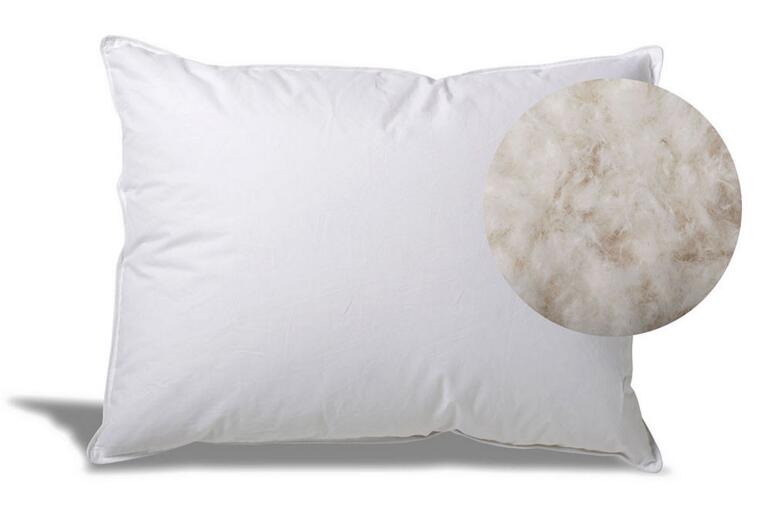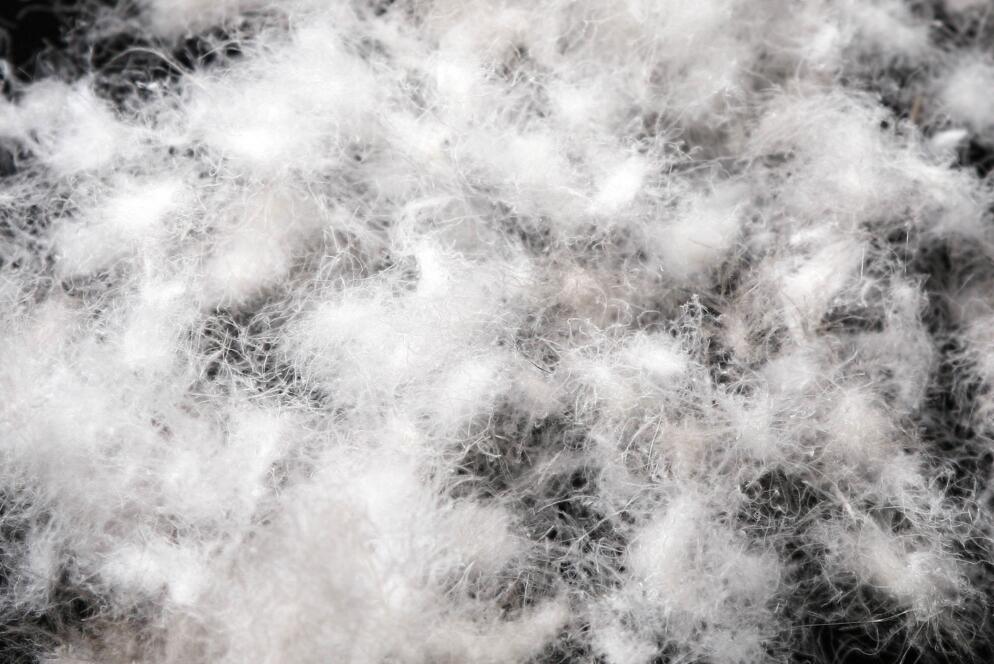 Fill power is a measure of the loft or “fluffiness” of a down product that is loosely related to the insulating value of the down. The higher the fill power the more air an ounce of the down can trap, and thus the more insulating ability an ounce of the down will have. Fill power ranges from about 300 (in³/oz or 175 cm³/g or Lorch 75 mm/30g) for feathers to around 900 (in³/oz or 520 cm³/g or Lorch 225 mm/30g) for the highest quality goose down. Although the rare and relatively expensive down of certain wild waterfowl species such as The Muscovy duck, or Common eider can have higher fill powers. Higher fill powers are associated with a larger percentage of down clusters and a larger average down cluster size.(Special link to down pillow manufacturer – Spring Homtextile)
Fill power is a measure of the loft or “fluffiness” of a down product that is loosely related to the insulating value of the down. The higher the fill power the more air an ounce of the down can trap, and thus the more insulating ability an ounce of the down will have. Fill power ranges from about 300 (in³/oz or 175 cm³/g or Lorch 75 mm/30g) for feathers to around 900 (in³/oz or 520 cm³/g or Lorch 225 mm/30g) for the highest quality goose down. Although the rare and relatively expensive down of certain wild waterfowl species such as The Muscovy duck, or Common eider can have higher fill powers. Higher fill powers are associated with a larger percentage of down clusters and a larger average down cluster size.(Special link to down pillow manufacturer – Spring Homtextile)

How to Measurement Fill Power
Fill power is the most frequently used measure of down quality. It involves measurements taken of a one-ounce sample of down in a plexiglas cylinder with a weighted piston compressing the down. The test requires controlled temperature, humidity, and preparation of the sample. All other things being equal a parka (duvet or sleeping bag) made with high fill power is lighter and more compressible than an equally warm one made with lower quality down. Fill power is expressed as cubic inches per ounce (in³/oz)—a lofting power of 400–450 is considered medium quality, 500-550 is considered good, 550–750 is considered very good, and 750+ is considered excellent.
US 2000 norm: cylinder diameter: 241 mm conditioning: steaming +3 to 5 days in a screen box compression cylinder: non-mechanized cylinder of 68,3 grams. Mass of the sample: 1 oz = 28,4 grams.
EN norm: cylinder diameter: (289 ± 1) mm, conditioning: tumble dry +2–5 days in a screen box compression cylinder: Lorch machine = mechanized cylinder weighing 94,25 grams, Mass of the sample:(20,0 ± 0,1) grams.
750+ fill is quite different from 400 fills. Almost all down commercially available is a secondary product of geese raised for consumption. It would be prohibitively expensive to raise geese for down alone. The geese that are the source for lower fill down are about four months old when they are “harvested” for food. Down from these geese can be carefully sorted, washed, and blended, but it will never loft like really mature down. The 700+ down fill comes from a small number of birds kept for breeding purposes throughout the year. These geese molt naturally in the spring. While their down is loose it is collected by hand. It is very rare and, of course, expensive. The larger individual plumules are what gives the greater loft. The only way to get down of this quality is by careful hand selection which is the major factor in its scarcity. The higher the fill number, the warmer the product is, given that the total mass remains the same.

Insulation and weight
Depending on the intended application, the highest available fill power may not be necessary. A high fill power will provide more insulating ability for a given weight of down. The warmth of a down comforter depends not only on the fill power, but also on the quantity of fill. So the difference between a comforter with 550 fill power down and a comforter with 700 fill power down is that the 700 fill power down comforter will be lighter for the same warmth rating. High fill powers are most important for weight sensitive applications such as backpacking.
Down (or any insulation) provides warmth by trapping a layer of air that separates the cold side from the warm side. A thicker layer of trapped air gives more insulation. This thickness is often called “loft.” A comforter that uses 550 fill power down, for example, would have to use approximately 40%-50% greater weight of down than a similar item that uses 800 fill power down to provide the same loft.(Special link to down pillow manufacturer by Spring Homtextile)
European sleeping bags
Calculations based on fill power and loft are only approximate. The warmth of sleeping bags may be more accurately compared using European Norm (EN 13537) temperature ratings that are based on realistic independent laboratory tests. The rated temperature (in degrees Celsius) is the lowest comfortable temperature. Often a table with values will be associated indicating safe but potentially not comfortable temperatures.
US sleeping bags
In the USA, sleeping bags are sold by temperature rating (in degrees Fahrenheit). Many US sleeping bag manufacturers use non-standardized methods to establish their temperature comfort ratings which means that ratings from different manufacturers may not be comparable. Some US manufacturers use EN 13537 and others are expected to adopt it in the future.
Washing and restoring
Fill power of down tends to diminish as the down gets dirty and mats. The fill power of a down article can be restored by washing the article in a washing machine with or without detergent (mild) and dried in a home dryer. Tennis balls can be added to help fluff the down. Alternatively, the washing can be skipped and the down article can be placed in the dryer with a damp rag for 10–20 minutes. The idea is to open up the matted down clusters with warm air and moisture.
Special treatments that increase fill power
Starting in 2012 and 2013, some manufacturers of down products devised a way to give their down the properties of waterproofness and enhanced fill-power. The loft-per-weight of the down was increased by these technologies, so that 800-fill down became 1000-fill and 900-fill became 1100-fill. Patagonia was one such company, using their technology named Encapsil to increase the fill power of the down in one 2013 jacket model from 800 to 1000.
To find more information on home textile industry, please visit us on www.springtextile.com.
Spring home textile based in Anhui, China, produce pillows, duvets, blankets and other on bed product. For any enquiry, please email us at: [email protected]
